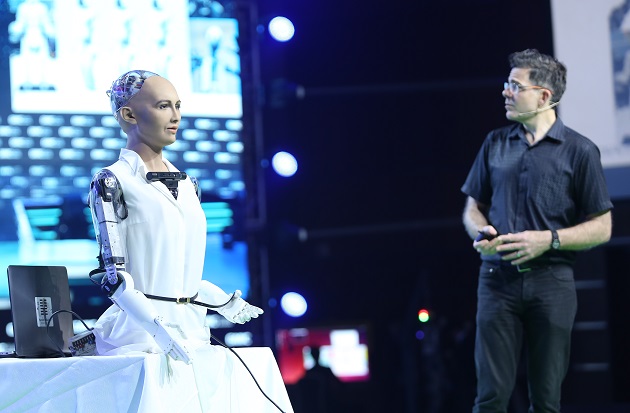The creation of human-robots can easily become an attempt not only to meet practical needs, but emotional needs too.
 Robot Sophia, in a presentation in Beijing, 2016. / Sophiabot.com
Robot Sophia, in a presentation in Beijing, 2016. / Sophiabot.com
Sophia the robot is back in the news at the 2017 Consumer Electronics Convention.
The creation of Hanson Robotics, Sophia is becoming something of a minor celebrity, making headlines last October when it was granted citizenship by Saudi Arabia.
More recently, it’s been given legs and has been reported as having taken its ‘first steps’.
In the increasing discussion around automation and robot ‘personhood’, Sophia provides a sensationalist spectacle—a supposed precursor to the new, artificial ‘people’ to come.
So, what is one to do in the face (literally) of increasingly sophisticated humanoid robots—otherwise known as androids? How do we think biblically about such a high tech issue?
Firstly, naiveté should be avoided. Christians are to be ‘wise as serpents’, discerning and undeceived. This is particularly important when we consider the words of history of technology professor, Melvin Kranzberg: ‘Technology is neither good nor bad; nor is it neutral.’[1] In other words, ‘the ethical impact of a technology is always subject to the ends of those who implement it.’ Since technology is being developed by some of the most powerful companies in the world, there is a moral imperative to be critical of those who create new technologies (and their motivations) to ensure that they are developed for the common good.
 An astronaut with the robot ‘TARS’ from Interstellar (2014).
An astronaut with the robot ‘TARS’ from Interstellar (2014).Secondly, it is vital to remember that the development of robots in humanoid form is only one trajectory of future possibilities for our world with robotics and AI. It is entirely possible to advocate the continued development of non-humanoid robots to assist with space exploration, such as the blocky robots TARS and CASE in the 2014 film, Interstellar, whilst turning a critical eye on the desire to create a robot that can ‘pass’ as a human.
Therefore, I propose three critical questions that we can apply to any humanoid robot, as we seek wisdom in the face of a narrative that claims that we can, and should, create people-like robots.
1. What is the purpose of the human-likeness effect?
In many cases, the end goal is empathy with robots, or paving the way for ‘seamless’ social integration. Sophia is listed as having ‘service robotics applications in business, medical/healthcare, and education.’[2] However, the creation of human-robots for these sectors can easily become an attempt not only to meet practical needs, but emotional needs too. For example, android carers for the elderly can more easily be seen as a substitute for human interaction than a non-human robot, potentially leading us to neglect the relational essence of care for older members of society. As Nigel Cameron has commented, it is the youngest and oldest in our society that are most at risk.
2. How is this android constructed?
Because of our own experience as holistic beings, it is very easy for us to observe a robot like Sophia and see it as a complete being. It is, however, a robotic platform for AI. As we begin to think through the components, we see through the ‘smoke and mirrors’ of the robot as a person which are amplified by the emotional effect of a human face (which is, after all, the image of God twice removed). Whether or not robots may one day ‘be conscious’, at the current time they are not and we should be suspicious of any presentation of androids that attempts to suggest otherwise.
3. Why make this specific body?
When we create an artificial body, we make certain choices, particularly regarding race and gender. It’s not a coincidence that ‘helpful’ personal assistants like Siri, Cortana and Alexa are all default female. If Sophia is about empathy, then how does its creation as woman reflect or reinforce cultural assumptions about women? Does it perpetuate a narrative that women are less threatening and more subservient than men? Does it matter that she’s a Caucasian woman? What standard of beauty has she been constructed to? And, returning us to our original question, is there a purpose or application for this specific body’s emotional effect?
We still have a lot of work to do in grappling with the full social and economic consequences of AI and robotics, however Christians should not shy away from seeking wisdom in this area.
Careful questioning, thoughtful prayer and a commitment to separating sensationalism from reality will help us to make a beginning.
Charlee New, Communications and Marketing Officer at the Jubilee Centre.
This article first appeared on the Jubilee Centre website and was republished with permission.
[1] Melvin Kranzberg, ‘Introduction: Technological and Cultural Change – Past, Present and Future’, in New Worlds, New Technologies, New Issues, ed. Stephen H. Sutcliffe. Research in Technology Studies, vol. 6, Lehigh University Press, 1992, p.100.
[2] http://www.hansonrobotics.com/robot/sophia/

Las opiniones vertidas por nuestros colaboradores se realizan a nivel personal, pudiendo coincidir o no con la postura de la dirección de Protestante Digital.
Si quieres comentar o